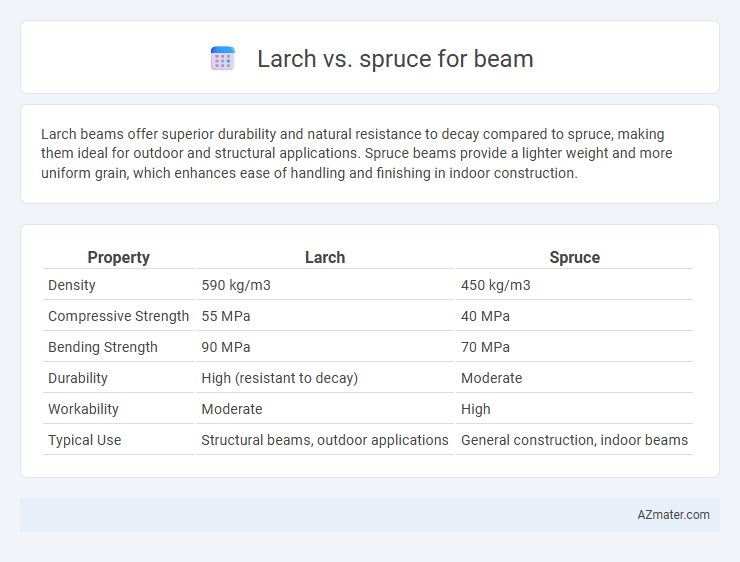Larch beams offer superior durability and natural resistance to decay compared to spruce, making them ideal for outdoor and structural applications. Spruce beams provide a lighter weight and more uniform grain, which enhances ease of handling and finishing in indoor construction.
Table of Comparison
| Property | Larch | Spruce |
|---|---|---|
| Density | 590 kg/m3 | 450 kg/m3 |
| Compressive Strength | 55 MPa | 40 MPa |
| Bending Strength | 90 MPa | 70 MPa |
| Durability | High (resistant to decay) | Moderate |
| Workability | Moderate | High |
| Typical Use | Structural beams, outdoor applications | General construction, indoor beams |
Introduction to Larch and Spruce Timbers
Larch timber is known for its exceptional durability, high resin content, and natural resistance to rot, making it a preferred choice for structural beams in outdoor and moist environments. Spruce timber, characterized by its light weight, uniform texture, and good strength-to-weight ratio, is commonly used for interior beams and framing where ease of handling and cost efficiency are priorities. Both Larch and Spruce exhibit favorable mechanical properties, but Larch often outperforms Spruce in terms of hardness and longevity under harsh conditions.
Key Differences Between Larch and Spruce
Larch wood exhibits higher density and natural durability compared to spruce, making it more resistant to decay and suitable for outdoor beam applications. Spruce offers a lighter weight and consistent straight grain, which facilitates easier handling and uniform load distribution in structural framing. The choice between larch and spruce beams depends on project requirements for strength, longevity, and exposure conditions.
Strength and Structural Performance
Larch offers superior strength and durability compared to spruce, making it ideal for heavy-duty beam applications that require high load-bearing capacity. Spruce, while lighter and easier to work with, typically has lower density and strength, which can limit its use in structural scenarios demanding maximum resilience. The higher modulus of elasticity in larch enhances its ability to resist bending and deformation, ensuring better long-term structural performance.
Durability and Lifespan Comparison
Larch beams offer superior natural durability due to their high resin content, making them resistant to decay and insect attacks, which extends their lifespan significantly compared to spruce. Spruce beams, while more affordable, typically require treatment to enhance durability and are more prone to rot and insect damage in exposed environments. The lifespan of larch beams can exceed 30 years under outdoor conditions, whereas untreated spruce beams may only last 15 to 20 years, highlighting larch as the better choice for long-term structural applications.
Resistance to Moisture and Decay
Larch beams exhibit superior resistance to moisture and decay due to their high resin content and dense grain, making them ideal for outdoor or humid environments. Spruce, while lighter and easier to work with, is more susceptible to rot and requires additional treatment to improve its durability. Choosing larch ensures longer-lasting structural integrity in moisture-prone applications compared to untreated spruce.
Workability: Ease of Cutting and Shaping
Larch offers moderate workability with a coarse texture that can be challenging to cut and shape compared to softwoods like spruce. Spruce is easier to work with due to its fine, straight grain and lower density, allowing smoother cutting and shaping for beams. For projects requiring precise detailing and faster processing, spruce is generally preferred over larch.
Appearance and Aesthetic Qualities
Larch beams exhibit a rich, warm hue with pronounced golden tones and distinctive resin canals that add natural texture and visual interest, making them ideal for rustic and traditional interiors. Spruce beams offer a lighter, pale color with a fine, uniform grain pattern that enhances modern and minimalist aesthetics by providing a clean, subtle appearance. The choice between Larch and Spruce beams hinges on whether a space calls for the bold character and intricate detailing of Larch or the understated elegance and smooth finish of Spruce.
Cost and Availability of Larch and Spruce
Larch timber generally costs more than spruce due to its higher density and durability, making it a preferred choice for structural beams where longevity is critical. Spruce is more widely available and typically less expensive, offering a cost-effective option for beams in standard construction projects. The availability of spruce is extensive in Northern Europe and North America, while larch, sourced mainly from Siberia and parts of Europe, has more seasonal and regional supply constraints.
Sustainability and Environmental Impact
Larch beams offer superior sustainability due to their natural durability and slower growth rate, which promotes forest conservation by reducing the need for frequent harvesting compared to faster-growing spruce. Spruce, while often preferred for its lightness and ease of use, typically requires more frequent replanting and energy-intensive processing, resulting in a higher carbon footprint. Choosing larch over spruce supports longer-lasting structures and enhances carbon sequestration, contributing to reduced environmental impact in timber construction.
Best Use Cases for Larch vs Spruce Beams
Larch beams offer superior durability and natural resistance to decay, making them ideal for outdoor structures and heavy load-bearing applications exposed to moisture. Spruce beams are lighter and easier to work with, making them best suited for interior framing, lightweight construction, and applications requiring quick installation. Both species provide strong structural support, but larch excels in longevity and weather resistance while spruce is preferred for cost-efficiency and ease of handling.

Infographic: Larch vs Spruce for Beam
 azmater.com
azmater.com